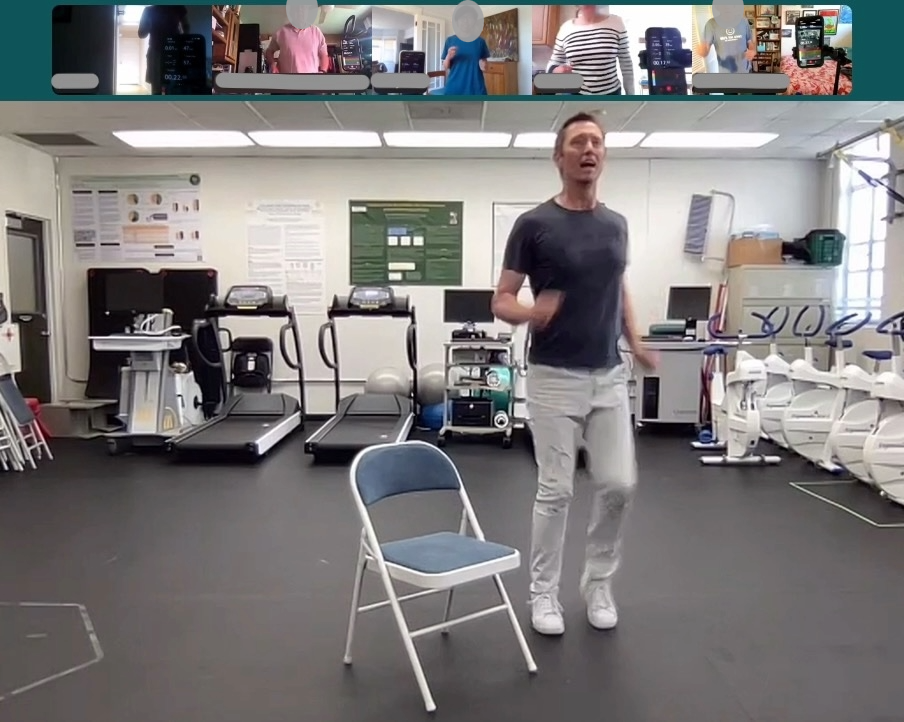The APEX project is supported by a grant from the National Institute on Deafness and Other Communication Disorders (R56DC020700).
In all, results of our pilot studies support the feasibility and fidelity of the novel HI-FIIV exercise program for stroke survivors. This new intervention addresses an important clinical need and is poised for successful implementation in a larger clinical trial exploring its multifaceted impact on aphasia recovery.
May 2025
APEX pilot study of a remote version of the HI-FIIV exercise program

In Spring 2025, we successfully completed a pilot study of the remote HI-FIIV program, marking an exciting milestone for the APEX project. Stroke survivors with aphasia were able to safely and effectively participate in live Zoom-based exercise classes led by a certified fitness instructor—all from the comfort of their homes. After just four weeks, participants showed significant and clinically meaningful improvements in multiple areas of physical fitness, including aerobic endurance and lower body strength. These results highlight the strong potential of the APEX program to be delivered remotely, making it more accessible and reducing common barriers to participation and dropout rates.
June 2024
APEX pilot study of the HI-FIIV program for stroke survivors with aphasia

In the winter-spring of 2024, we conducted a small study to evaluate how well the HI-FIIV program works for stroke survivors with aphasia. Our pilot data clearly demonstrated that people with aphasia can successfully engage in the high-intensity exercise program. The program effectively accommodated participants with varying degrees of language and motor impairments, including severe hemiparesis, and showed very promising trends in terms of behavioral changes. Specifically, the study addressed the following questions:
Can stroke survivors with reduced mobility and fitness levels safely engage in and complete a high-intensity interval training (HIIT) exercise program?
- Individuals with aphasia can safely and successfully engage in the high-intensity APEX exercise program.
- The program’s structure effectively accommodates participants with varying degrees of motor and language impairments.
- All participants with aphasia safely completed the HIIT exercise program with no incidents concerning the safety of the APEX program itself.
Can participants with aphasia adhere to a rigorous exercise program?
- Stroke survivors were consistently engaged and highly motivated to attend in-person classes held 3 times a week and adhere to the exercise regimen.
- Attendance rates among participants with aphasia were exceptionally high, with 98% attendance across all 24 sessions.
- Participants displayed high levels of enthusiasm and motivation, eagerly completing the exercise regimen.
Can PWA achieve a true cardiovascular workout with HI-FIIV?
- The HI-FIIV program elicited appropriate physiological response in participants with aphasia, with heart rates aligning with existing HIIT guidelines.
- As can be seen in the Figure below, all participants achieved their heart rate goals, validating the program’s high-intensity nature and the application of this HIIT format in the stroke population.

Can participation in the HI-FIIV program lead to changes in physical fitness?
- Stroke survivors with aphasia demonstrated clinically meaningful improvements in multiple domains of physical fitness, including aerobic endurance, lower body strength, dynamic and static balance.
- Improvements in aerobic endurance were particularly notable. Aerobic endurance is an indicator of cardiovascular fitness and is directly linked to cardiovascular health.
- Two participants with right-sided hemiparesis also had a marked increase in gait speed.

This Figure shows examples of changes on the physical fitness measures from pre- to post-intervention. The bars indicate group averages at pre (light blue bars) and post-intervention (navy bars), the colored lines show individual data. The data highlight that all participants showed pronounced improvements on physical fitness measures following the HI-FIIV program.
Can participation in the HI-FIIV program lead to changes in cognitive and language abilities?
- Participants also showed promising improvements in multiple cognitive and language abilities, including executive control, working memory, sentence-level comprehension, and verbal fluency.
November 2023
Pilot study of the HI-FIIV program in healthy older controls
The HI-FIIV program was found to be safe and feasible in healthy older adults with no adverse events and high levels of adherence. Recorded heart rates aligned with HIIT guidelines in high-intensity and recovery periods, validating the fidelity of the protocol. Further, functional fitness gains were observed in aerobic endurance, lower body strength, agility, gait, balance, and joint mobility. Exercise-mediated positive trends in cognition were noted in working memory and executive control tasks. These results support further exploration of the HI-FIIV program in stroke survivors.